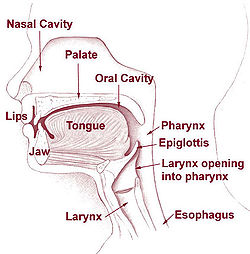- Mouth
-
This article is about the anatomical structure. For other uses, see Mouth (disambiguation).
Mouth 
Head and neck. 
A closed human female mouth Latin os, cavitas oralis MeSH Oral+cavity The mouth is the first portion of the alimentary canal that receives food and saliva.[1] The oral mucosa is the mucous membrane epithelium lining the inside of the mouth.
In addition to its primary role as the beginning of the digestive system, in humans the mouth also plays a significant role in communication. While primary aspects of the voice are produced in the throat, the tongue, lips, and jaw are also needed to produce the range of sounds included in human language. Another non-digestive function of the mouth is its role in secondary social and/or sexual activity, such as kissing.
The mouth, normally moist, is lined with a mucous membrane, and contains the teeth. The lips mark the transition from mucous membrane to skin, which covers most of the body.
Contents
In Humans
Mouth cavity
The first space of the mouth is the mouth cavity, bounded laterally and in front by the alveolar arches (containing the teeth), and posteriorily by the isthmus of the fauces. The oral cavity is also known as the mouth which swallows food and drinks that then go down the esophagus and into the stomach.
Function
The mouth plays an important role in ,eating, drinking, and breathing. Infants are born with a sucking reflex, by which they instinctively know to suck for nourishment using their lips and jaw.
Cultural aspects
According to Western etiquette, the mouth is kept closed, especially when chewing.
Lips can be adorned with lipstick or lip gloss, although in most cultures this is typically only practiced by females. Both men and women, however, apply lip balm in order to soothe chapped or dry lips.
Piercings in or around the mouth have been made popular by younger generations, including those on the lip or tongue. The uvula piercing, while increasing in popularity, remains relatively rare.
Development
The philtrum is the vertical groove in the upper lip, formed where the nasomedial and maxillary processes meet during embryo development. When these processes fail to fuse fully, a hare lip and/or cleft palate can result.
The nasolabial folds are the deep creases of tissue that extend from the nose to the sides of the mouth. One of the first signs of age on the human face is the increase in prominence of the nasolabial folds.
In non-human animals
Some animal phyla, including vertebrates, have a complete digestive system, with a mouth at one end and an anus at the other. Which end forms first in ontogeny is a criterion used to classify animals into protostome and deuterostome. The first space of the mouth is the mouth cavity, bounded laterally and in front by the alveolar arches (containing the teeth), and posteriorly by the isthmus of the fauces.[1]
See also
- Head and neck anatomy
- Mouth breathing
- Index of oral health and dental articles
- List of basic dentistry topics
- Tonsillolith
- Arthropod mouthparts
- Insect mouthparts
References
External links
- oral+cavity at eMedicine Dictionary
Human regional anatomy (TA A01.1) Head 
Neck Trunk Limbs Lower limb/
(see also leg)General anatomy: systems and organs, regional anatomy, planes and lines, superficial axial anatomy, superficial anatomy of limbsHead and neck anatomy, digestive system: Mouth anatomy (TA A05.1–2, TH H3.04.01, GA 11.1110–2, 1125–1141) Mouth Lip (Upper, Lower, Vermilion border, Frenulum of lower lip, Labial commissure of mouth, Philtrum)
Cheek (Buccal fat pad)Interdental papilla · Gingival sulcus · Gingival margin · Free gingival margin · Gingival fibers · Junctional epithelium · Mucogingival junction · Sulcular epithelium · Stippling
Periodontium: Cementum · Gingiva · Periodontal ligamentTeethsee tooth anatomydorsum (Taste bud, Median sulcus, Terminal sulcus, Foramen cecum, Lingual tonsils) · underside (Frenulum, Fimbriated fold, Sublingual caruncle) · Anterior · Posterior · Glossoepiglottic folds · Lingual septumOro-pharynx/
fauces
This anatomy article is a stub. You can help Wikipedia by expanding it.


